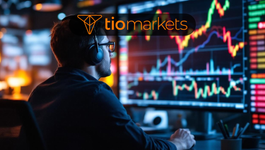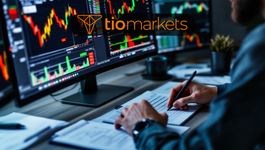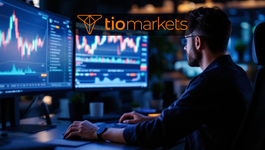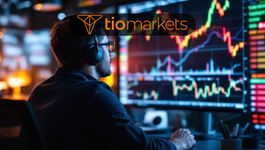How to Use Moving Averages in Forex Trading
BY TIOmarkets
|mayo 30, 2024Moving averages are a cornerstone in the world of Forex trading, offering traders a streamlined method to gauge market trends and make informed decisions. This guide delves into the practical application of moving averages, aiming to equip traders with the knowledge to harness this tool effectively.
Understanding Moving Averages
Moving averages smooth out price data to create a single flowing line, making it easier to identify the direction of the trend. This simplicity is key to their widespread use among traders.
There are several types of moving averages, each with its own calculation method and use case, which we will explore in detail.
Simple Moving Average (SMA)
The Simple Moving Average (SMA) is calculated by adding the prices of a set number of time periods and then dividing by the number of periods. This average moves over time, hence the term "moving."
SMAs are particularly useful for identifying support and resistance levels, and their simplicity makes them a favorite among many traders.
Exponential Moving Average (EMA)
The Exponential Moving Average (EMA) gives more weight to recent prices, making it more responsive to new information. This can be particularly useful in fast-moving markets.
EMAs are preferred by traders looking to make quick decisions based on the latest market trends.
Applying Moving Averages in Trading Strategies
Moving averages can be used in various ways to inform trading strategies. Below, we explore some of the most effective methods.
Trend Confirmation
A moving average can help confirm the direction of a trend. A rising moving average indicates an uptrend, while a falling moving average suggests a downtrend.
This method is straightforward but powerful, providing a clear signal for entering or exiting trades.
Support and Resistance Levels
Moving averages can act as dynamic support and resistance levels. Traders often buy when the price touches the moving average in an uptrend and sell in a downtrend.
This approach requires careful observation and timing to maximize effectiveness.
Crossovers
A crossover occurs when two moving averages cross each other. A bullish signal is generated when a shorter-term moving average crosses above a longer-term average, while a bearish signal is indicated by the opposite movement.
Crossovers can signal the beginning of a new trend, making them valuable for traders looking to catch early movements.
Risks and Considerations
While moving averages are powerful tools, they come with their own set of risks and considerations.
Lagging Indicator
As moving averages are based on past prices, they are inherently lagging. This means they can sometimes signal a trend change only after it has begun, potentially reducing profitability.
Traders should combine moving averages with other indicators to mitigate this risk.
False Signals
Moving averages can generate false signals, especially in sideways or choppy markets. A crossover in such conditions may not signify a sustainable trend.
It's crucial for traders to recognize market conditions and adjust their strategies accordingly.
Additional Strategies for Using Moving Averages
Aside from the common uses of moving averages discussed earlier, there are additional strategies that traders can employ to enhance their trading decisions.
Moving Average Convergence Divergence (MACD)
The MACD is a popular technical analysis indicator that utilizes moving averages to identify potential changes in trends. It consists of the MACD line, signal line, and histogram, providing traders with multiple signals.
By incorporating the MACD alongside traditional moving averages, traders can gain deeper insights into market dynamics.
Multiple Moving Averages
Some traders use multiple moving averages of varying lengths to generate more nuanced trading signals. By analyzing the interactions between different moving averages, traders can identify complex market trends.
This approach requires a thorough understanding of each moving average's characteristics and how they complement each other.
Implementing Moving Averages in Automated Trading Systems
With the advancement of technology, many traders are incorporating moving averages into automated trading systems. These systems use predefined algorithms to execute trades based on moving average signals.
Automated systems can operate 24/7, removing human emotions from trading decisions and ensuring consistent adherence to predefined strategies.
Backtesting and Optimization
Before deploying an automated trading system based on moving averages, it's essential to conduct thorough backtesting and optimization. This process involves testing the system's performance against historical data and fine-tuning parameters for optimal results.
By backtesting and optimizing moving average strategies, traders can increase the likelihood of success in live trading environments.
Conclusion
Moving averages are a versatile and essential tool in Forex trading, offering a simple yet effective method for analyzing market trends. By understanding and applying moving averages correctly, traders can significantly enhance their trading strategies. However, it's important to remember that no indicator is foolproof. Combining moving averages with other technical analysis tools and a solid risk management strategy is the key to success in the volatile world of Forex trading.
- Pros of Moving Averages:
- Simplicity and ease of use
- Effectiveness in identifying trends
- Utility in determining support and resistance levels
- Cons of Moving Averages:
- Potential for lag in signaling trend changes
- Risk of false signals in non-trending markets
By carefully considering these factors and employing moving averages as part of a comprehensive trading strategy, traders can navigate the Forex markets with greater confidence and success.
Start Trading with TIOmarkets
Ready to put your knowledge of moving averages to the test in the real Forex market? Join TIOmarkets, the top-rated broker with over 170,000 accounts opened in more than 170 countries. Take advantage of our low fees and trade over 300 instruments across 5 markets, including Forex, indices, stocks, commodities, and futures. Enhance your trading skills with our comprehensive educational resources and step-by-step guides. Don't wait any longer to elevate your trading journey. Create a Trading Account today and start trading with TIOmarkets!

Risk disclaimer: CFDs are complex instruments and come with a high risk of losing money rapidly due to leverage. You should consider whether you understand how CFDs work and whether you can afford to take the high risk of losing your money. Never deposit more than you are prepared to lose. Professional client’s losses can exceed their deposit. Please see our risk warning policy and seek independent professional advice if you do not fully understand. This information is not directed or intended for distribution to or use by residents of certain countries/jurisdictions including, but not limited to, USA & OFAC. The Company holds the right to alter the aforementioned list of countries at its own discretion.
Join us on social media

Behind every blog post lies the combined experience of the people working at TIOmarkets. We are a team of dedicated industry professionals and financial markets enthusiasts committed to providing you with trading education and financial markets commentary. Our goal is to help empower you with the knowledge you need to trade in the markets effectively.
Related Posts





